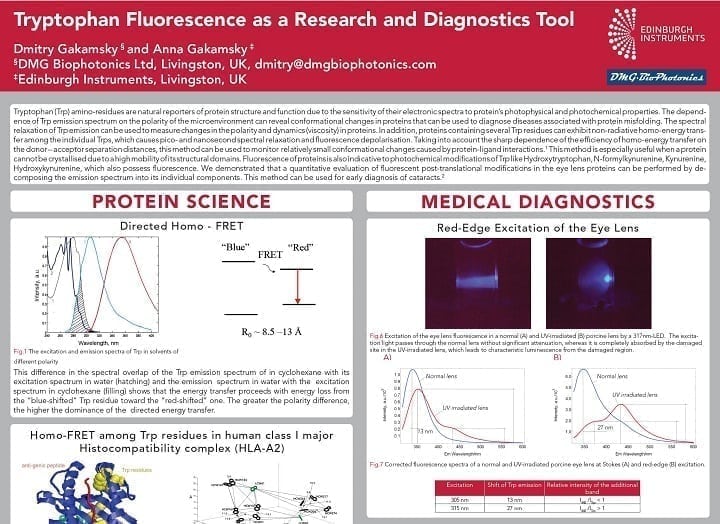Tryptophan Fluorescence as a Research and Diagnostics Tool – FB3 Glasgow.
Dr. Anna Gakamsky, Applications Engineer at Edinburgh Instruments, and Dr. Dmitry Gakamsky, CEO at DMG Biophotonics recently presented their research on Tryptophan Fluorescence as a Research and Diagnostics Tool at Fluorescent Biomolecules and Their Building Blocks (FB3) at Glasgow University. You can read about their research and download their poster in this article.
Tryptophan (Trp) amino-residues are natural reporters of protein structure and function due to the sensitivity of their electronic spectra to protein’s photophysical and photochemical properties. The dependence of Trp emission spectrum on the polarity of the microenvironment can reveal conformational changes in proteins that can be used to diagnose diseases associated with protein misfolding. The spectral relaxation of Trp emission can be used to measure changes in the polarity and dynamics (viscosity) in proteins.
In addition, proteins containing several Trp residues can exhibit non-radiative homo-energy transfer among the individual Trps, which causes pico- and nanosecond spectral relaxation and fluorescence depolarisation. Taking into account the sharp dependence of the efficiency of homo-energy transfer on the donor – acceptor separation distances, this method can be used to monitor relatively small conformational changes caused by protein-ligand interactions1. This method is especially useful when a protein cannot be crystallised due to a high mobility of its structural domains. Fluorescence of proteins is also indicative to photochemical modifications of Trp like Hydroxytryptophan, N-formylkynurenine, Kynurenine, Hydroxykynurenine, which also possess fluorescence.
Anna Gakamsky and Dmitry Gakamsky also demonstrated that a quantitative evaluation of fluorescent post-translational modifications in the eye lens proteins can be performed by decomposing the emission spectrum into its individual components. This method can be used for early diagnosis of cataracts2.
Tryptophan Fluorescence as a Research and Diagnostics Tool
Download Dr. Anna Gakamsky and Dr. Dimitry Gakamsky’s complete research poster Tryptophan Fluorescence as a Research and Diagnostics Tool.
FLS1000
Edinburgh Instruments’ FLS1000 spectrometer was used to carry out this research. For further information on the FLS1000 or any of our products, please contact us. We’d be delighted to help you with your enquiry.
Email Newsletter
Why not sign-up to our monthly e-newsletter and we will keep you up to date with our latest research, application notes and company news. You sign-up via the red button below.









